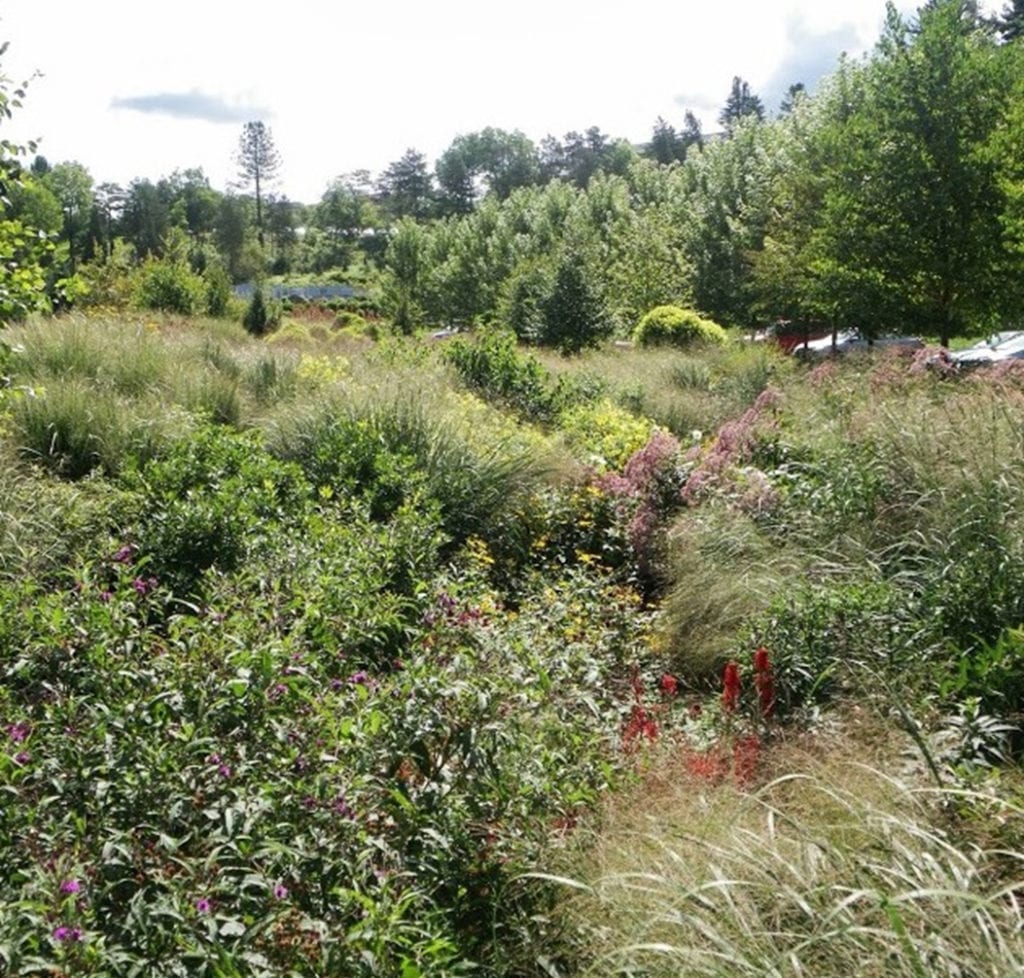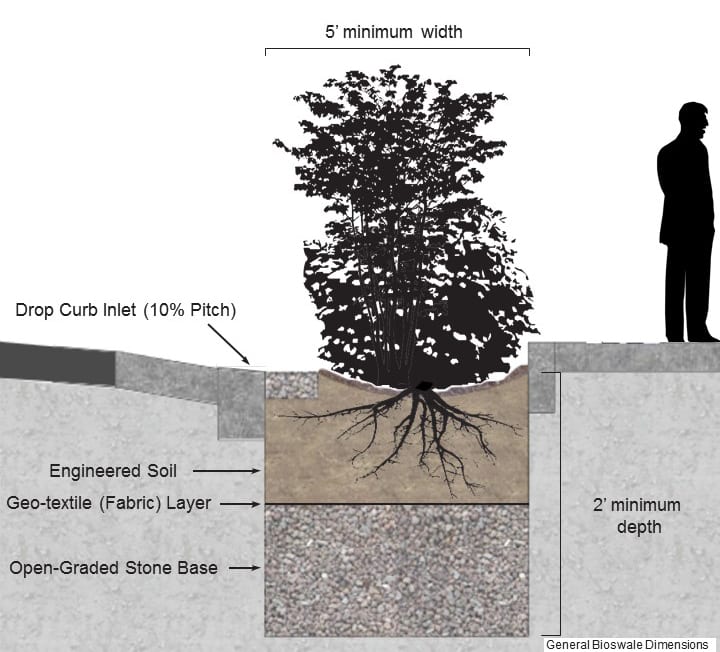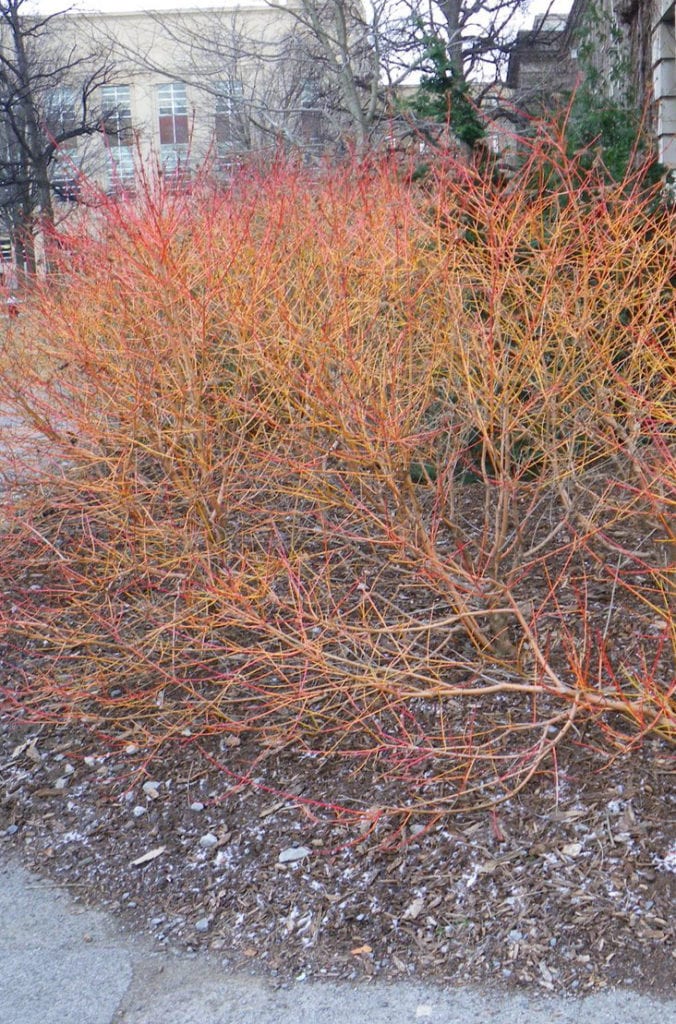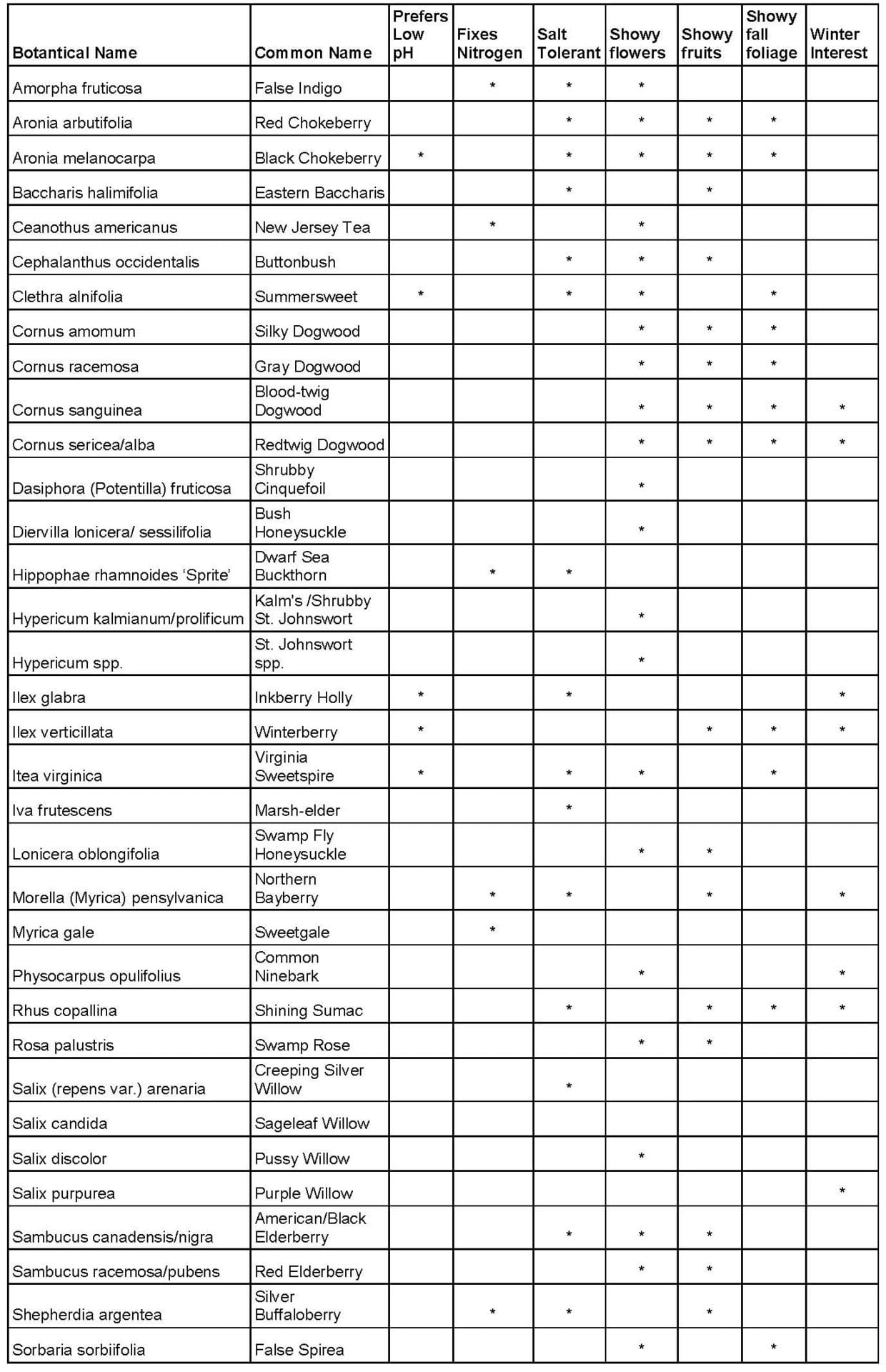by Ethan Dropkin and Dr. Nina Bassuk
This article is a condensed version of Cornell University Urban Horticulture Institute’s publication of Woody Shrubs for Stormwater Retention Practices, a guide for the layman and professional that outlines the issues associated with stormwater, details the methods for mitigating these issues, and provides a comprehensive list of woody shrubs which have proven success rates in retention and infiltration practices.
Introduction to Stormwater
Stormwater (rain or snowmelt which flows over the ground and does not directly infiltrate into the soil) has become increasingly problematic in recent years, particularly in urban areas. Increased volumes of stormwater runoff caused by a proliferation of impervious surface area and compacted soils have resulted in a variety of issues including, but not limited to, sedimentation, erosion, nutrient loading (resulting in low-oxygen water conditions), pollution (chloride, hydrocarbons, pesticides, litter, etc.), and bacterial contamination of water sources especially in conditions where sanitary sewer is combined with stormwater (particularly problematic in urban centers with aging sewer systems like New York, Chicago, and Washington D.C., etc.).
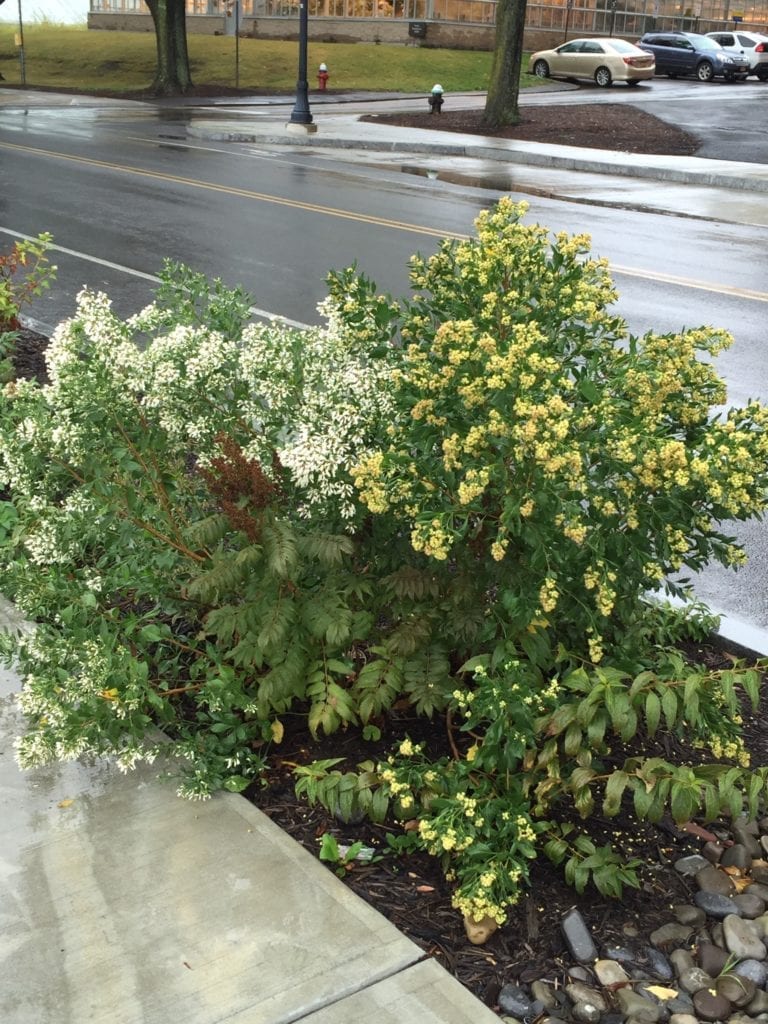
The woody plant stormwater retention planting along Tower Road at Cornell University features male and female Baccharis halimifolia and Sorbaria sorbiifolia ‘Senn.’
Many of the systems and practices which contribute to this problem are heavily entrenched pieces of our existing infrastructure such as: outdated sewage systems and acres of impervious roofs, sidewalks, parking lots, roads, etc. While these practices may remain stuck in the past, the regulations in place to mitigate them are increasingly concerned with the future health of our aquatic systems. At all levels of government, the impacts of past mishandling of stormwater management have resulted in broad-scale initiatives to improve our practices and, as a result, improve overall water and environmental quality.
A large part of each of these regulatory plans is the creation of stormwater infiltration practices. Stormwater infiltration practices come in a variety of forms but their overall goal is to slow, retain, and in certain cases detain stormwater during and after a storm event. Their goal is to capture pollutants before they enter the larger watershed and to improve water quality overall. Of particular interest are a number of the planted stormwater infiltration practices that have developed recently.
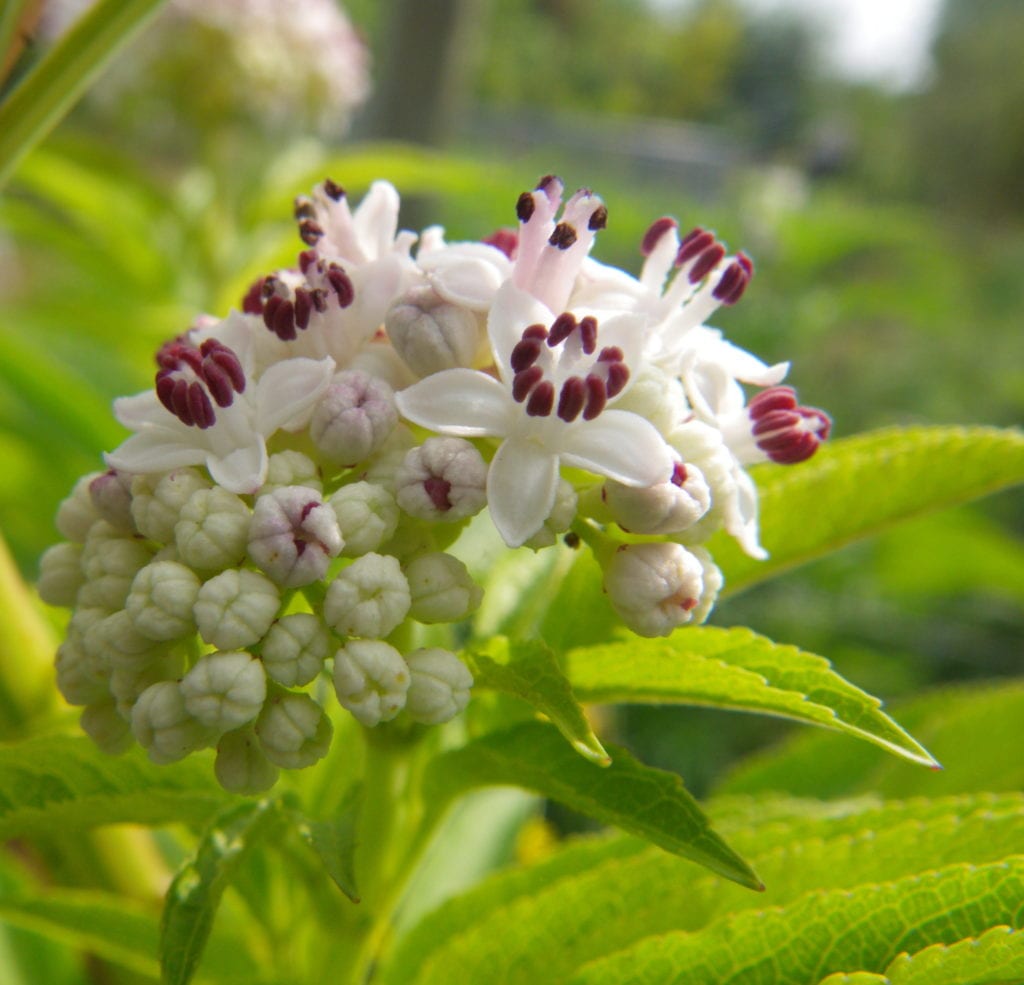
American Elderberrgy (Sambucus canadensis) offers showy flowers and fruit in addition to a stormwater planting.
The Importance of Plants
Plants play a variety of important roles in the success of stormwater infiltration practices. Plant roots help with water infiltration, soil stabilization, and the filtering of pollutants. Plant stems help slow runoff which in turn may cause some suspended solids, sediment, etc. to settle out of the water. Plant leaves improve air quality through uptake of gaseous pollutants and help reduce the urban heat island effect through evaporative cooling and shading. Finally, plants help add aesthetic value and educational potential to our urban spaces while increasing biodiversity and creating wildlife habitat. Given all of these benefits, it seems critical that plants be included in stormwater practices whenever possible.
When selecting plants for stormwater infiltration, common sense would seem to dictate the use of wetland plants. However, due to the rate at which most of these practices allow water to infiltrate, the majority of planted stormwater practices will likely be inundated for only a few minutes after a small storm event and up to a day or two for a larger event. Unlike most permanent or semi-permanent wetlands, these areas remain relatively dry most of the time. Because of this characteristic, plants that can handle both temporary inundation and relatively protracted drought are the best choices for a low-maintenance planting.
Most stormwater treatment planting guidelines suggest the use of native plants exclusively. However due to the unique moisture/drought tolerances required for successful growth in these sorts of practices, it would be imprudent to exclude non-native plants. Because of the growth limitations associated with these planting areas, any plant that can succeed on site and is not invasive should be considered.
To promote plantings with reduced maintenance costs, the value of woody plants, specifically shrubs, should be considered. While herbaceous plants may establish more quickly and fill a site, they require at least yearly pruning post-establishment to remove dead foliage and seasonal die-back. Woody plants however—due to their generally slower growth rate and more permanent growth habit—require far less pruning, potentially only once every three years, reducing the overall amount of maintenance significantly.

This successful stormwater retention planting in a Syracuse, NY public park incorporates a variety of woody plant material.
Site Assessment
Assessing a site and its surroundings is important for a successful stormwater landscape installation. In the case of most stormwater retention/infiltration practices, significant engineering below ground will be necessary to control the amount and rate of stormwater retention/infiltration. While these considerations are important when preparing the site for stormwater practices, plants have factors which are specific to their success. These include:
Exposure – the amount of sun or shade a site receives
Hardiness – whether the plant will be able to survive the temperature extremes of the region
Microclimates – understanding how the surroundings of a planting may subtly affect the extremely local climate of a planting
Soil Fertility and pH – whether the soil to be used in a planting has nutrient levels and pH that can support long-term growth of the proposed plants
Soil Conditions – knowing the initial soil conditions will be important in creating the specification of what should be installed on site
Salt Inputs – how much salt spray and saltwater run-off will the plants be likely to be exposed to
Irrigation Access – plants may need supplemental watering to keep them growing and thriving until their roots are established and even after initial establishment plants may need irrigation during periods of prolonged drought, as is the case with any planting
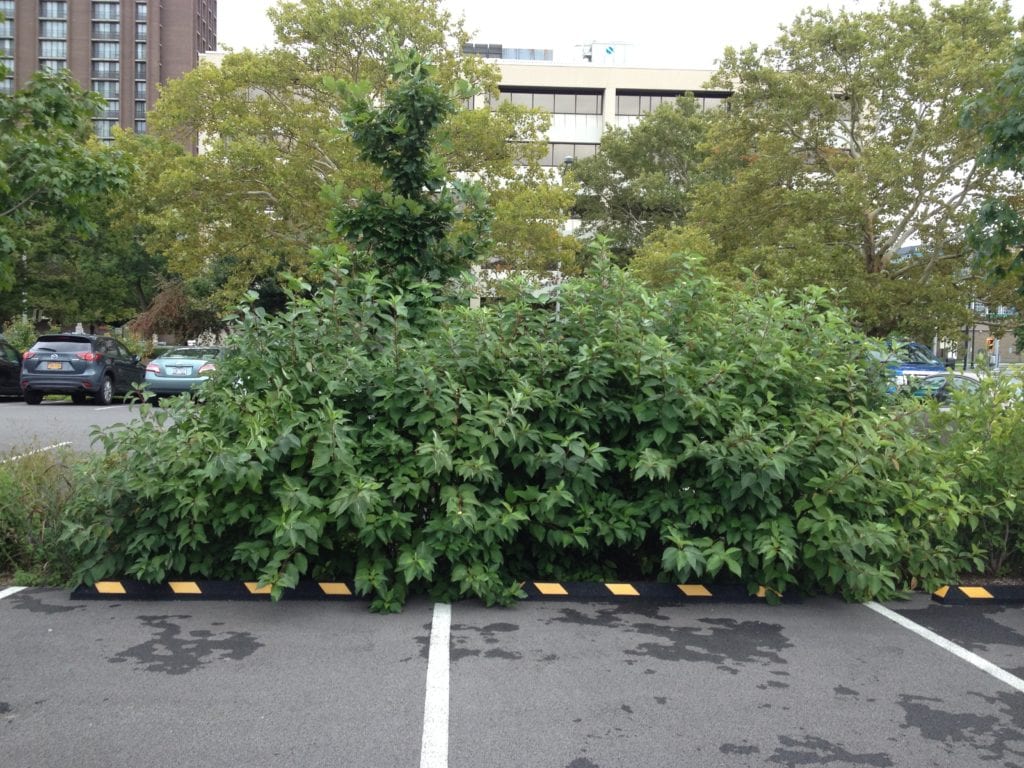
A Cornus sericea mass works well as part of a stormwater retention planting in a Syracuse, NY municipal parking lot.
Design Considerations Prior to Plant Selection
Site design requirements will vary greatly depending on the type of stormwater collection practice intended for the site. However, some factors will be a part of any design, including:
- regrading the surrounding site to direct stormwater into the collection basin
- creation of a basin sized large enough to handle the volume of water it is intended to hold
- installation of planting substrate and sub-surface soil layers which may include but are not limited to mulch, an engineered soil mix, geotextile fabric, and an open-graded stone base course
- selection of hi-hat drains, perforated piping, stone filled drainage columns, and/or conventional storm sewer connections to assists with drainage/remove excess water from the site during severe storm events
- installation of fencing or tree-pit guards depending on the drop from sidewalk/street level which is created
These and other site design criteria may impact plant selection, location, installation, and maintenance requirements. Early stage planning to create plantings which assist rather than impair the long-term function of stormwater practices are integral in the success of a project.
Maintenance
Maintenance requirements for stormwater infiltration/retention vary depending on whether the desired aesthetic is formal or more naturalistic. Regardless, it is important to create a regular maintenance plan for these sites so that they do not become unsightly, unsafe, or non-functional.
Regular maintenance tasks will likely include:
- regular weeding throughout the establishment period, with a likely reduction in weeding frequency once shrubs establish and form a closed canopy
- yearly mulching of established plantings
- watering during dry periods, especially during the first two years of establishment
- pruning and thinning on a rolling three-year cycle; this will be important for some plants to improve ornamental characteristics, encourage new growth, and to control form and size
- pruning of dead, damaged, diseased, and hazard branches/foliage
- periodic flushing of trapped sediments from catch basins, pipes, or gravel to maintain drainage and remove flow obstructions
- replacement of dead plants
Plant Selection
The complete copy of Woody Shrubs for Stormwater Retention Practices includes a list of woody shrubs for use in planted stormwater retention and infiltration practices. These plants were selected because of their performance in an experimental trial performed by the authors, their proven use in New York City and/or Syracuse’s stormwater planting practices, or their documented cultural tolerances. All plants included have been proven hardy in the Northeast. This list is by no means comprehensive. Rather, it is a tested or observed sample of the large array of shrubs suited for use in the periodically saturated locations often encountered at the bottom of stormwater practices.
Below is a simplified list of the plants described in the pamphlet which can further help in selecting the right plant for a site.
For a more in-depth treatment of individual plants and more detail on the preceding information, access the original pamphlet: http://www.hort.cornell.edu/uhi/outreach/pdfs/woody_shrubs_stormwater_hi_res.pdf
About the Authors
Ethan M. Dropkin received a BA in Secondary Education from the University of Vermont in 2006. In 2013 he was awarded a Masters in Landscape Architecture from Cornell University followed by a Masters of Professional Studies in Horticulture in 2014, also from Cornell. Ethan has worked as a horticultural technician, gardener and designer for: the New York City Department of Parks and Recreation, Cornell Plantations, Cornell University, Roger Miller Gardens, and Michael Van Valkenburgh Associates. He currently works for Larry Weaner Landscape Associates as a landscape designer with a focus on sustainable native landscapes.
Dr. Nina Bassuk has been a professor and program leader of the Urban Horticulture Institute at Cornell University for the past 30 years. She is a member of the Executive Committee of the New York State Urban Forestry Council. In addition, Dr. Bassuk co-authored Trees in the Urban Landscape, a text on establishing trees in disturbed and urban landscapes, and has written hundreds of papers on the physiological problems of plants growing in urban environments, improved plant selections for difficult sites, soil modification (including the development of CU-Structural Soil), and transplanting technology.
Each author appearing herein retains original copyright. Right to reproduce or disseminate all material herein, including to Columbia University Library’s CAUSEWAY Project, is otherwise reserved by ELA. Please contact ELA for permission to reprint.
Mention of products is not intended to constitute endorsement. Opinions expressed in this newsletter do not necessarily represent those of ELA’s directors, staff, or members.

